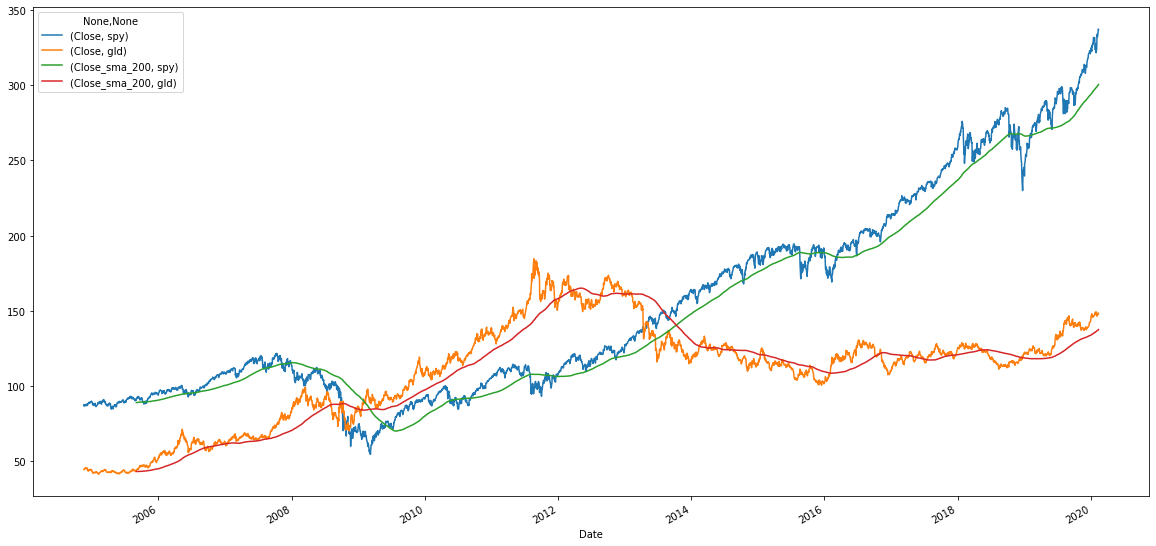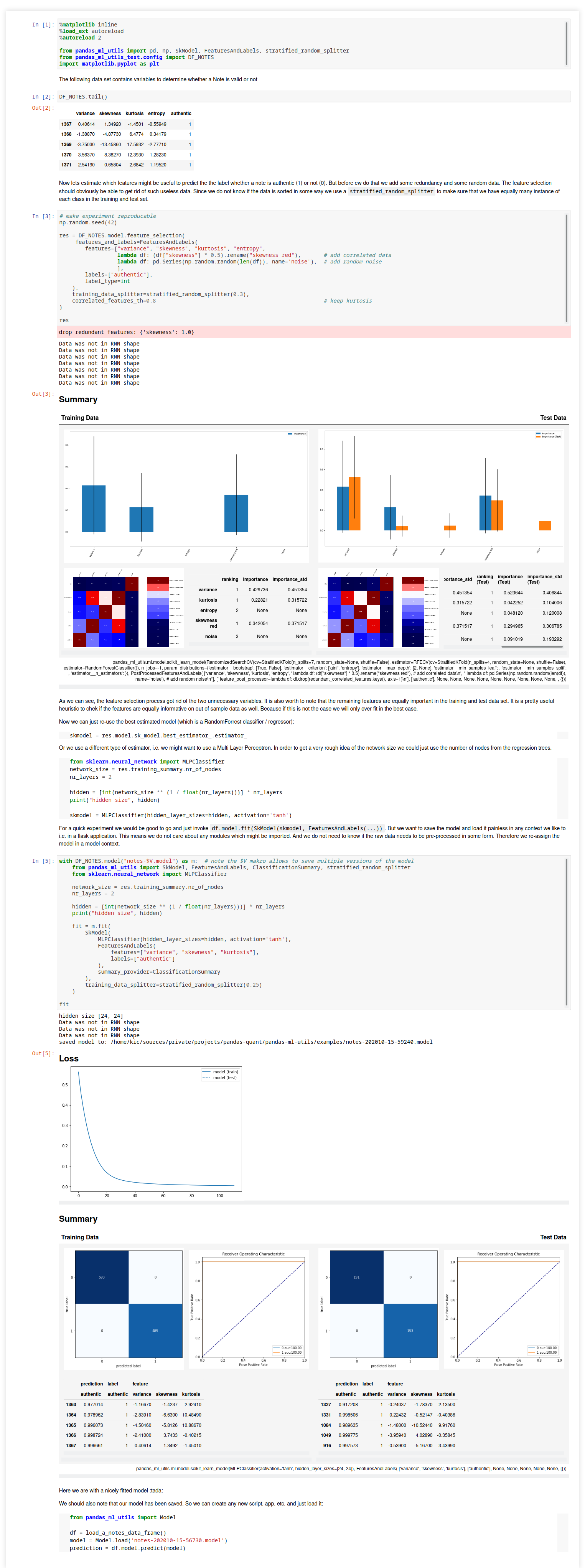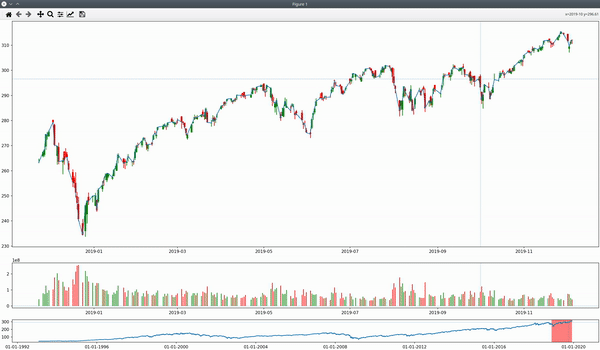NOTE: Future development happens at https://github.com/Pandas-Quant-Finance
However, this is still the library I currently use in production.
Whether it is some statistical analysis or machine learning, most likely it all starts with a DataFrame.
But soon enough you will find yourself converting your data frames to numpy, splitting arrays, applying min
max scalers, lagging and concatenating columns etc. As a result your notebook looks messy and became and
unreadable beast. Yet the mess becomes only worse once you start to deploy your research into a productive
application. Now the untested hard coded data pipelines need to be maintained at two places.
The aim of this library is to conveniently operate with data frames without and abstract away the ugly unreproducible data pipelines. The only thing you need is the original unprocessed data frame where you started.
 You find this demo in the pytorch examples
You find this demo in the pytorch examples
The data pipeline becomes a part of your model and gets saved that way. Going into production is as easy as this:
import pandas as pd
import pandas_ml_utils # monkey patch the `DataFrame`
from pandas_ml_utils import Model
# alternatively as a one liner `from pandas_ml_utils import pd, Model`
model = Model.load('your_saved.model')
df = pd.read_csv('your_raw_data.csv')
df_prediction = df.model.predict(model)
# do something with your prediction
df_prediction.plot()The project is divided into several sub modules where each module could have its own life-cycle. It is definitely an option to move the modules into their own repository in the future if there will be dedicated contributors.
The submodules are:
- pandas-ml-1ntegration-test more complex tests involving several modules and eventually external data
- pandas-ml-airflow a very experimental module to integrate models within apache airflow
- pandas-ml-common functionalities around data access and preparation like train/test splitting, cross validation, ...
- pandas-ml-quant enhancing pandas-ml-utils for modeling financial timeseries
- pandas-ml-quant-rl very experimental module for reinforcement learning
- pandas-ml-utils core module to train models directly from a pandas data frame
- pandas-ml-utils-keras deprecated module, might be revoked using tensorflow probability
- pandas-ml-utils-torch pytorch module for machine learning
- pandas-quant-data-provider easy wrapper around data providers like yahoo and investpy
- pandas-ta-quant technical analysis functionality like TA-Lib
- pandas-ta-quant-plot plotting library to simulate state of the art financial plots (also very early stage)
This module contains helpers and utilities for the most common tasks like:
- splitting data and generation of cross validation data sets
- nesting and unnesting of multi dimensional column data like images or geodata
- helpers for pandas
MultiIndexes - dependency injection
- data serialization
The main abstraction layer for data selection, preparation and modelling. The core object is the FeaturesAndLabels
definition. Very high level your models will look something along the lines:
from pandas_ml_utils import pd
df = pd.DataFrame({})
with df.model('file_name') as m:
# use a context manager and import all your dependencies locally
# and create all objects needed for your model
# this makes sure when you save (pickle) your model that it can load conveniently without polluting
# your global name space
from pandas_ml_utils import SkModel, FeaturesAndLabels, FittingParameter, RegressionSummary, naive_splitter
from sklearn.neural_network import MLPRegressor
fit = m.fit(
SkModel(
MLPRegressor(activation='tanh', hidden_layer_sizes=(60, 50), random_state=42, max_iter=2),
FeaturesAndLabels(
features=[
"some_column",
lambda df: df["some_column"].apply(lambda x: "some calculation"),
],
labels=[
lambda df: df["some_column"].apply(lambda x: "some calculation")
]
),
summary_provider=RegressionSummary
),
FittingParameter(naive_splitter())
)
fit # finally just return fit as the `Fit` object implements `_repr_html_()` which renders a nice reportBefore a model can be developed, features need to be selected.
df.model.feature_selection(
FeaturesAndLabels(
features=[...],
labels=[...]
)
)Check this demo from the examples:
Extends the pandas-ml-utils library for the use of pytorch models
Extends the pandas-ml-utils library for the use of keras tensorflow 1.x models.
NOTE! This module is currently stalled as I mainly use pytorch at the moment.
...
Technical analysis library.
It is a pure python re-implementation of the famous TA-Lib and some custom indicators on top i.e. GARCH.
Use df.ta.help to see all possible indicators.

Charting library
This is mainly a wrapper around data providing libraries yfinance or investpy
There are some more not published libraries used for testing and experiments.
Currently, all libraries are somewhat entangled and will hike parallel the releases cycles. This dependency will weaken up as we reach more stable release.
pip install pandas-ml-common pandas-ml-utils pandas-ml-utils-torch\
pandas-ta-quant pandas-ml-quant\
pandas-quant-data-provider pandas-ta-quant-plot

